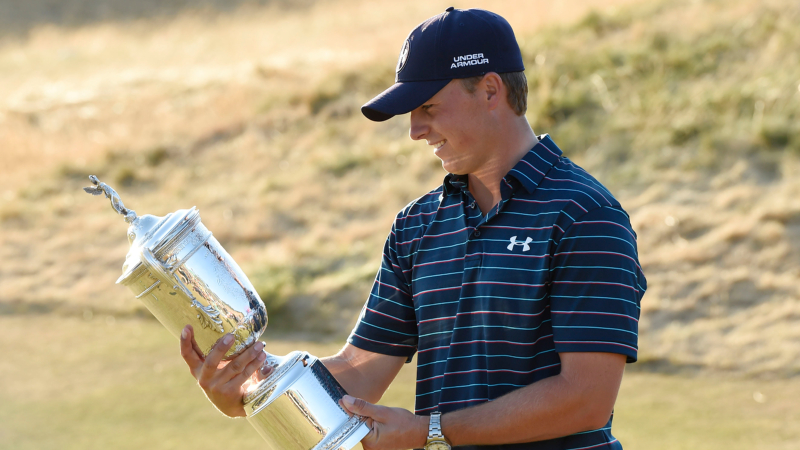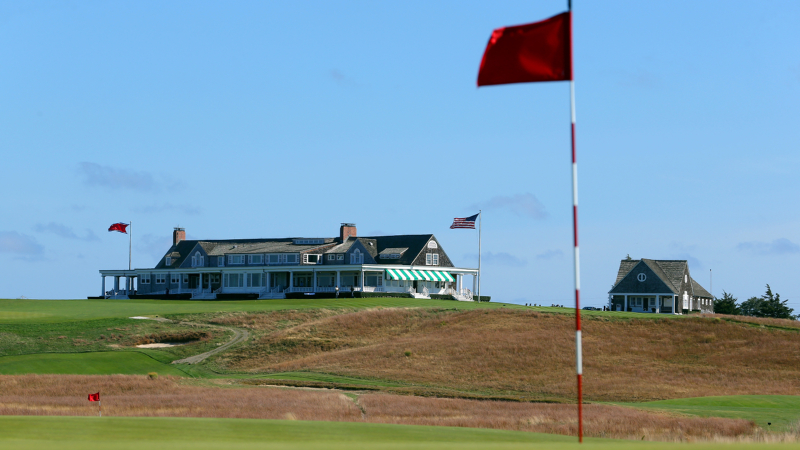The PGA Breakdown offers data-driven analysis for each week’s slate, using the FantasyLabs Tools and metrics to highlight notable golfers.
Ah, the moment we’ve been waiting for since The Masters. The U.S. Open is finally here, and it’s going to be good. This week, 156 of the best players in the world will tee it up at Shinnecock Hills. It should be noted that only the top 60 (and ties) will make the cut after 36 holes, which is different than your average PGA event. This is the fifth time the U.S. Open will be hosted here, but the course has taken on a few renovations since it was last played here in 2004.
The Course
In 2004, Shinnecock Hills checked in at 6,996 yards: Fast forward to 2018, and it now sits at a little over 7,440 yards, which makes it a uniquely long Par-70. Shinnecock Hills’ average fairway width in 2004 was 26.6 yards, and now it has increased to 41.6. While that’s good news, it still plays nearly 20 yards narrower in some spots compared to Erin Hills at last year’s U.S. Open. There isn’t much leeway for errant tee shots. The golfers who are inaccurate will quickly find themselves in the fescue.
16th pic.twitter.com/9IqH9u1c81
— Richie Ramsay (@RamsayGolf) June 11, 2018
With the length of the course, golfers who are long off the tee will have an obvious advantage provided they can keep the ball in play. There are six Par-4s that are 450 yards or longer, which makes par-4 scoring equally as crucial. There’s even a 252-yard Par-3.
Additionally, the grass is mowed very thin around the greens, which means that an inaccurate shot could cause the ball simply to roll right off. Wind could also play a huge factor since all the trees were ripped out in the renovation, so be sure to check golfer’s tee times and leverage the Wind Score metric in our PGA Models.
With the format of the majors, we don’t have any data to backtest within our Trends tool, but metrics I’ll be paying attention to include:
- Long-Term Adjusted Round Score (LT Adj Rd Score)
- Driving Distance (DD)
- Driving Accuracy (DA)
- Greens in Regulation (GIR)
- Par-4 Scoring
- Birdie Scoring
- Bogey Avoidance
All listed prices are for DraftKings.
The Studs
Dustin Johnson ($11,700) will likely have high ownership, especially after his walk-off win at Southwind last week. He checks in with the highest odds (11.1%) to win, and rightfully so because he’s the top-ranked golfer in the world. More importantly, DJ boasts the best LT Adj Rd Score (67.7) in the field. Rostering DJ just comes down to how you want your lineup to look. In a loaded field, there’s no shortage of value plays in the $7,000 range to accommodate DJ, but you’ll need to find a way to differentiate your roster.
Rory McIlroy ($11,500) is a couple hundred dollars cheaper than DJ, and he has the second-highest odds to win (6.7%). Rory has the distance to compete here with his 312.8-yard LT DD, and he can hit GIR at a decent rate (66.5% over the past 75 weeks). Overall, Rory could see reduced ownership with a salary so close to DJ’s.
Justin Thomas ($11,000), like the majority of the top-priced guys, is long off the tee, sporting a LT DD of 310.3 yards. He’s also an excellent Par-4 scorer, averaging -2.3 average adjusted strokes on Par-4s over the past 75 weeks. Relative to DJ, he’ll also (like Rory) have diminished popularity.
Jordan Spieth ($10,800) is a tough player to gauge. He owns the fourth-best LT Adj Rd Score (68.2) in the field and boasts a field-best -2.9 average adjusted strokes on Par-4s. Moreover, Spieth has hit 70.2% of GIR along with just 7.6 bogies per tournament over the past 75 weeks. He has the talent to win, but he has struggled of late. Over his past four rounds, he ranks 110th in Strokes Gained: Approach and 69th in Strokes Gained: Around the Green. Furthermore, he’s struggled in the short game, ranking 94th in Strokes Gained: Putting this season. If he can progress back to his long-term form, he could play like the best in the field, but his recent form is that of a struggling golfer.
Jason Day ($10,600) has the upside and distance to win, but his recent hot streak has mostly been due to his putter (27.1 putts per round) and scrambling, saving par on 72.9% of holes. Putting can be streaky, and if he’s not getting up-and-down for par at a high rate then he could regress rapidly at a tough U.S. Open course. Day’s 9.8 bogies per tournament over the past 75 weeks is actually the sixth-worst mark in the field.
The newly engaged Rickie Fowler ($10,200) has the balanced game to take care of business at Shinnecock Hills. He’s tied with Paul Casey and trails only DJ, Justin Rose, and Thomas with his 68.2 LT Adj Rd Score. His combination of driving distance and accuracy suits the course well, as do his solid ball-striking, scrambling, and putting. Fowler can do it all. The only thing he hasn’t done is win a major — but he does own nine top-10 finishes in his 31 major appearances.
The Value Plays
One way to find value is to leverage our LT Adj Rd Score metric. If you sort the field by LT Adj Rd Score, you are looking at a list of players who have been the best golfers over the past 75 weeks. Among these golfers, those who have low salaries make great value plays.
Tony Finau ($7,500) is the 34th-most expensive golfer but owns the ninth-best LT Adj Rd Score (68.6). Finau should thrive on the Par-4s, as six of them check in at 450 yards or longer. This season, Finau ranks 19th in strokes gained on Par-4s between 450 and 500 yards. Finau’s primary concern will be keeping the ball in the fairway, since he ranks 104th in Fairways Gained.
Matt Kuchar ($7,600) is short off the tee, but he has the balanced game that usually makes for safe DFS investment. Kuchar boasts an excellent 68.8 LT Adj Rd Score, and he’s missed just 8% of cuts over the past 75 weeks (the fifth-best mark in the field). Further, Kuchar should be able to avoid trouble for the most part since he’s accurate off the tee (65.3% LT DA). The greens at Shinnecock will be challenging, but it should help that Kuchar ranks 12th in proximity to the hole and 18th in Strokes Gained: Putting this season. Kuchar hasn’t missed a cut at a U.S. Open since 2009.
Kyle Stanley ($7,200) is reasonably long off the tee (295-yard LT DD) and accurate (69% LT DA). Further, he’s an excellent ball-striker, hitting 69.6% of GIR over the past 75 weeks. Overall, Stanley is a solid DFS play, ranking 22nd in Strokes Gained: Ball-Striking and 20th in Par-4s gained. With the importance of hitting GIR and fairways, it’s difficult not to consider a guy who ranks fourth in fairways gained and fifth in GIR gained on tour this season.
Chesson Hadley ($7,000) is one of three players in this field to have gained strokes on Par-3s, Par-4s and Par-5s over the past 75 weeks. (The two others are Henrik Stenson at $8,800 and DJ.) Hadley owns a 303.3-yard LT DD, and he’s hitting 61.7% of his fairways (past 75 weeks). Of the 34 golfers in the FantasyLabs database who own a LT DD of at least 300 yards, only 13 have hit at least 60% of fairways. He’s also hitting 69.4% of GIR within the same time frame. His -1.0 average adjusted strokes on Par-4s is the 10th-best mark in the field. Hadley is sharp on the green, ranking sixth in Strokes Gained: Putting over his past 12 rounds.
Marc Leishman ($7,800) is sporting a 68.6 LT Adj Rd Score and is considerably cheap. Also, as discussed on the “Daily Fantasy Flex” podcast, Leishman is one of the best golfers in the wind, which could be a huge factor this week.
Patrick Cantlay ($7,700) checks in as another golfer priced quite low in this loaded field, but he’s tied with Leishman with the eighth-best LT Adj Rd Score.
The Bump and Run
Justin Rose ($9,900): He checks in tied with Thomas for the second-best LT Adj Rd Score (68.1), but he’s at least $1,000 cheaper than the top-priced guys. Rose is averaging a field-best 16.9 birdies per tournament over the past 75 weeks, and his average adjusted strokes on Par-4s (-1.8) and 5-s (-5.8) are both top-six marks in the field. His 70.5% LT GIR is also higher than that of everyone priced above him. Giddyup!
Paul Casey ($8,000): He is habitually underpriced in stacked fields, owning an incredible 68.2 LT Adj Rd Score (fourth-best mark). Moreover, he’s one of the best ball-strikers on tour, hitting 68.6% of GIR over the past 75 weeks and ranking 10th in Strokes Gained: Tee-to-Green this season. That said, he oddly has struggled at U.S. Opens. Per Bryan Mears, Casey has just one top-10 finish in 14 U.S. Open events while finishing outside the top 25 in every one since 2007.
John Rahm ($9,500): He can be a headcase at times, which makes him risky in tough course conditions, but Rahm owns an excellent 68.3 LT Adj Rd Score, and he can crush the ball (306.6-yard LT DD). Furthermore, his -2.2 average adjusted strokes on Par-4s is the fourth-best mark in the field. Rahm’s distance off the tee and Par-4 scoring could be valuable on a course of this length.
Steve Stricker ($6,900): He’s 51 years old, but his -2.1 average adjusted strokes on Par-4s is the fifth-best mark in this talented field. While his 286.1-yard LT DD puts him at a disadvantage, his 73.7% LT DA gives him an edge along with his 71.3% GIR over the past 75 weeks. Even though he is short off the tee, his average adjusted strokes on Par-5s (-5.3) is the ninth-best mark in the field, and Stricker is great at avoiding bogies as evidenced by his 7.1 per tournament.
Last, but not least: With the importance of GIR and bogey avoidance, look no further than Stenson and Tommy Fleetwood ($8,100), who can hit fairways and greens with the best of them:

Good luck, and be sure to check out The Action Network if you’re looking for more golf coverage!
Pictured above: Justin Rose and Tiger Woods
Photo credit: Aaron Doster-USA TODAY Sports







